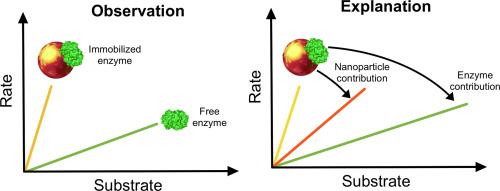Journal of Catalysis ( IF 6.5 ) Pub Date : 2021-11-09 , DOI: 10.1016/j.jcat.2021.10.036 Eimantas Ramonas 1, 2 , Atefeh Shafaat 3, 4 , Marius Dagys 2 , Tautgirdas Ruzgas 3, 4 , Dalius Ratautas 1, 2

|
In recent years, many papers have reported a catalytic “acceleration” of enzymes when immobilized on gold nanoparticles. Concordantly, gold nanoparticles are often considered as an inert and safe nanomaterial, and are widely used for various purposes, e.g., experiments with humans are being conducted in vivo. In this work we have carried out an in-detail study of catalytic properties of citrate-capped gold nanoparticles and gold nanoparticle-protein conjugates using three model proteins – enzymes glucose oxidase and catalase, and catalytically inactive protein bovine serum albumin. Catalytic properties were studied at different protein-nanoparticle ratios. UV–Vis, DLS, AFM and ζ potential measurements confirmed protein-nanoparticle conjugate formation. Catalytic activity measurements were conducted using oxygen electrode and the data were analyzed by modeling the activity of conjugates. The designed experiments demonstrated that gold nanoparticles form stable conjugates with all the investigated proteins, yet they do not increase catalytic activity of the investigated enzymes – in certain conditions gold nanoparticles mimic enzymatic reactions, which may be misattributed to accelerated enzymatic catalysis. Additionally, we present specific key points demonstrating why it may be difficult to differentiate between enzyme- and gold nanoparticle-catalyzed reactions, as well as suggest specific measurements enabling better differentiation. We do not claim that enzymes cannot be accelerated on nanoparticles in general, but rather emphasize, that experimental results demonstrating atypical catalytic performance of enzymes on nanoparticles should be interpreted with additional care, and a widely propagated view of “inert gold nanoparticles” should probably be reconsidered.
中文翻译:

修正柠檬酸盐封端的金纳米粒子上酶的催化“加速”
近年来,许多论文报道了酶固定在金纳米粒子上时的催化“加速”。相应地,金纳米粒子通常被认为是一种惰性且安全的纳米材料,并被广泛用于各种目的,例如在体内进行人体实验. 在这项工作中,我们使用三种模型蛋白质——葡萄糖氧化酶和过氧化氢酶,以及无催化活性的蛋白质牛血清白蛋白,对柠檬酸盐封端的金纳米颗粒和金纳米颗粒-蛋白质缀合物的催化特性进行了详细研究。在不同的蛋白质-纳米颗粒比率下研究了催化特性。UV-Vis、DLS、AFM 和 ζ 电位测量证实了蛋白质-纳米颗粒共轭物的形成。使用氧电极进行催化活性测量,并通过模拟缀合物的活性来分析数据。设计的实验表明,金纳米粒子与所有研究的蛋白质形成稳定的共轭物,但它们不会增加所研究酶的催化活性——在某些条件下,金纳米粒子模拟酶促反应,这可能被错误地归因于加速的酶催化。此外,我们提出了具体的关键点,说明为什么可能难以区分酶催化反应和金纳米颗粒催化反应,并提出了能够更好区分的特定测量方法。我们并不声称酶不能在一般情况下在纳米粒子上加速,而是强调,应该格外小心地解释证明酶对纳米粒子具有非典型催化性能的实验结果,并且可能应该广泛传播“惰性金纳米粒子”的观点重新考虑。以及建议特定的测量方法,以实现更好的区分。我们并不声称酶不能在一般情况下在纳米粒子上加速,而是强调,应该格外小心地解释证明酶对纳米粒子具有非典型催化性能的实验结果,并且可能应该广泛传播“惰性金纳米粒子”的观点重新考虑。以及建议特定的测量方法,以实现更好的区分。我们并不声称酶不能在一般情况下在纳米粒子上加速,而是强调,应该格外小心地解释证明酶对纳米粒子具有非典型催化性能的实验结果,并且可能应该广泛传播“惰性金纳米粒子”的观点重新考虑。











































 京公网安备 11010802027423号
京公网安备 11010802027423号